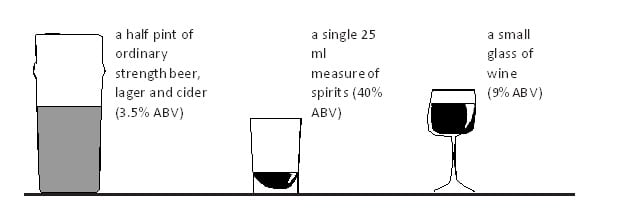Alcohol and Drugs at Work part 1- Alcohol.
Often in training courses, the subject of Alcohol and Drugs comes up. Many of the delegates on these courses, are surprised when I supply them with the facts.
Drug, alcohol and other substance misuse is everyone’s concern. It damages health, causes absenteeism and reduced productivity
So, over this week and next week I will look at Alcohol and Drugs to hopefully make you all aware of the risks. I will also try and outline the employer’s position and explain what he can and cannot do if he has an employee with a drink or drugs problem. This week I will look at Alcohol.
This week’s 2 recent HSE cases look at accidents where there was a lack of H&S management.
- The inspection found that numerous areas of the site had no edge protection to prevent falls, including where workers could fall four metres into the basement from the site entrance area.
- An asbestos removal company, and two of its managers, have today been prosecuted after forging documents in order to obtain an asbestos licence from the Health and Safety Executive
As ever, if you have a subject that you would like us to cover one week, please contact us by phone 01458 253682, email or via our Facebook page or by Twitter
Alcohol and Drugs at Work part 1- Alcohol
This is aimed at all employees and employers and looks at alcohol-related problems in the workplace.
Here I will describe the effects of alcohol and how much alcohol you can drink safely. I will also provide a guide as to the approach employers could take for tackling problems related to alcohol.
So, let’s start with some basic facts about how alcohol can affect your business:
17% of personnel directors in a survey, described alcohol consumption as a ‘major problem’ for their organisation. What concerned directors most, in order of priority, was:
- loss of productivity and poor performance;
- lateness and absenteeism;
- safety concerns;
- effect on team morale and employee relations;
- bad behaviour or poor discipline;
- adverse effects on company image and customer relations.
These concerns are equally important for small and medium-sized businesses.
They fall into two main areas:
Alcohol-related absenteeism and sickness absence.
Alcohol is estimated to cause 3-5% of all absences from work; about 8 to 14 million lost working days in the UK each year.3 How much is alcohol-related absence costing your
business?
The effects of drinking on productivity and safety.
Alcohol consumption may result in reduced work performance, damaged customer relations, and resentment among employees who have to ‘carry’ colleagues whose work
declines because of their drinking. There are no precise figures on the number of workplace accidents where alcohol is a factor, but alcohol is known to affect judgement and physical co-ordination. Drinking even small amounts of alcohol before or while carrying out work that is ‘safety sensitive’ will increase the risk of an accident.
Contrary to popular belief, the majority of people who have a drinking problem are in work. The good news is that people with drink problems can and do cut down, and that there are places throughout the country where people with drinking problems can go for expert help.
The prospect of tackling when and how much employees drink can be daunting, especially for businesses without a personnel specialist. But acting to prevent problems before they occur can save time in the end and is often more effective than dealing with a problem that has become too serious to ignore.
Drinking alcohol: Effects on the individual
Before thinking about what you can do to prevent alcohol-related problems for your business, it is worth looking briefly at how drinking alcohol affects people and your legal responsibilities as an employer.
Alcohol is a positive part of life for many people and most of the time drinking alcohol doesn’t cause any problems. But drinking too much or at the wrong time can be harmful.
The following as examples of specific situations when the best advice is not to drink at all:
⦁ before or during driving;
⦁ before using machinery, electrical equipment or ladders;
⦁ before working or in the workplace when appropriate functioning would be adversely affected by alcohol.
So what happens when you drink alcohol?
- Alcohol is absorbed into your bloodstream within a few minutes of being drunk and carried to all parts
of your body including the brain. - The concentration of alcohol in the body, known as the ‘blood alcohol concentration’, depends on many factors, but principally, how much you have drunk, how long you have been drinking, whether you have eaten, and your size and weight. It is difficult to know exactly how much alcohol is in your bloodstream or what effect it may have
- It takes a healthy liver about 1 hour to break down and remove 1 unit of alcohol. A unit is equivalent to 8 gm or 10 ml (1 cl) of pure alcohol. The following all contain one unit of alcohol:

- If someone drinks 2 pints of ordinary strength beer at lunchtime or half a bottle of wine (i.e. 4 units), they will still have alcohol in their bloodstream 4 hours later. Similarly, if someone drinks heavily in the evening they may still be over the legal drink drive limit the following morning.
- Black coffee, cold showers and fresh air won’t sober someone up. Only time can remove alcohol from the bloodstream.
It is easy to see from this how drinking alcohol at lunchtime or before coming on shift can affect an employee’s work performance. But please note: The effects of heavy drinking the previous night can last well into the next day. On these courses I often have delegates admit to consuming 30 units of alcohol on a Friday night out. (So, the alcohol from Friday night is still in their bloodstream on Sunday morning)
But of course, they also have a few drinks on Saturday and Sunday. How much alcohol is still in their bloodstream on Monday morning when they return to work?
Even at blood alcohol concentrations lower than the legal drink/drive limit, alcohol reduces physical co-ordination and reaction speeds. It also affects thinking, judgement and mood. People may feel more relaxed and less inhibited after a couple of drinks but getting drunk can lead to arguments, mood swings, and even violence. Large amounts of alcohol in one session can put a strain not just on the liver but other parts of the body as well, including muscle function and stamina.
After getting drunk, you should avoid drinking alcohol for 48 hours to give your body tissue time to recover. However, this is a short-term measure and people whose pattern of drinking places them at significant risk should seek professional
advice.
Drinking alcohol raises the drinker’s blood pressure. This can increase the risk of coronary heart disease and some kinds of stroke. Regularly drinking more than the daily benchmarks (3-4 Units a day for Men 2-3 Units for Women) also increases the risk of liver damage, cirrhosis of the liver, and cancers of the mouth and throat. People who drink very heavily may develop psychological and emotional problems, including depression.
Studies show that people who regularly drink small amounts of alcohol tend to live longer than people who do not drink. The main reason is that alcohol gives protection against the development of coronary heart disease.4 However, this protective effect is only significant when people reach a stage of life when they are at risk of coronary heart disease. For men, this is over the age of 40. For women, it is after the menopause. The benefits come from drinking small amounts of alcohol regularly – i.e. between 1 and 2 units a day. No overall additional benefit comes from drinking more than 2 units a day, or from drinking a particular type of drink (eg red wine).
The legal position
You have a general duty under the Health and Safety at Work etc Act 1974 to ensure, as far as is reasonably practicable, the health, safety and welfare of your employees.
If you knowingly allow an employee under the influence of excess alcohol to continue working and this places the employee or others at risk, you could be prosecuted. Similarly, your employees are also required to take reasonable care of themselves and others who could be affected by what they do.
In the transport industry, there is additional legislation in place to control the misuse of alcohol and drugs. The Transport and Works Act 1992 makes it a criminal offence for certain workers to be unfit through drink and/or drugs while working on railways, tramways and other guided transport systems. The operators of the transport system would also be guilty of an offence unless they had shown all due diligence in trying to prevent such an offence being committed.
What can you do as an employer?
A straightforward four-step process for dealing with alcohol problems at work is set out below. All companies – large and small – can benefit from an agreed policy on alcohol.
Step 1 Find out if there is a problem
Problems may come from employees:
- drinking during working hours;
- drinking during breaks or before coming on shift;
- regular heavy drinking outside working hours;
- getting drunk outside working hours.
You may find it useful to find out from your employees what they know about the effects of alcohol on health and safety, what they feel currently about drinking alcohol during working hours and their understanding of any restrictions or rules on alcohol use in your business.
You may also want to explore the information you have on:
- sickness absence;
- productivity;
- accident records;
- disciplinary problems. This may help you to find out if alcohol is harming your business.
There are many reasons why someone develops a drinking problem. Working conditions – for example stress, excessive work pressure, unsocial hours or monotony – may be a factor in someone starting to drink more. Opportunity can also be a factor; for example in jobs where there is ready access to alcohol or where drinking and entertaining is a normal part of doing business. Lack of supervision combined with opportunities to drink during working hours may mean that a drinking problem goes unnoticed.
People with drinking problems are not, however, the sole cause of alcohol-related problems at work. A business will suffer if any employee drinks during working hours in such a way that the work suffers, phones in sick after a heavy drinking session the night before or comes to work with a hangover.
Step 2 Decide what to do
Dealing with an employee with a possible alcohol problem:
- Employees with a drink problem have the same rights to confidentiality and support as they would if they had any other medical or psychological condition.
- Disciplinary action should be a last resort. A court may find a dismissal unfair if an employer has made no attempt to help an employee whose work problems are related to drinking alcohol.
- The cost of recruiting and training a replacement may be greater than the cost of allowing someone time off to obtain expert help.
- Many people with an alcohol problem are able in time to regain full control over their drinking and return to their previous work performance.
- It may be very difficult for people to admit to themselves or others that their drinking is out of control. They need to know that you will treat their drinking problem as a health problem rather than an immediate cause for dismissal or disciplinary action.
- If employees’ drinking is a matter of concern, they should be encouraged to seek help from their GP or a specialist alcohol agency.
Consulting others
In deciding what to do, you will almost certainly need to consult others. In larger organisations, good practice would be to set up a working party led by a senior manager to look at the issue of alcohol as it affects the business, also involving the occupational health practitioner where available.
This may not be feasible in smaller businesses, but you will find it useful to talk to:
- other business owners;
- supervisors;
- staff representatives/trade union representatives;
- employees.
Gaining the support of your workforce for any change in company rules will be much easier if staff feel that they have been consulted beforehand. You may be surprised by the reactions of your staff. The culture surrounding drinking during working hours has changed dramatically over the past decade.
Step 3 Taking action
In taking action, you need to ensure that you have the support of other managers and gain the support of your employees. The personal involvement of the boss will also make a huge difference when it comes to introducing any changes. The most important questions are:
- What needs to be done?
- Who needs to do it?
You also need to think about communication and training. How will current staff and any recruited in the future know the company’s rules about drinking? Doesanyone need more information or training?
Supervisors and other managers need to be clear about company rules and what to do if they suspect employees’ drinking is affecting their work. They also need to be aware of the implications of not tackling possible alcohol misuse, especially where safety is an issue.
Many larger organisations have a policy that describes their position on employees’ drinking. A written alcohol policy has many advantages, for example leaving less room for misunderstanding than an informal ‘understanding’.
Providing information
You may find that by making general information about alcohol and health available to your staff, you are encouraging sensible drinking outside working hours.
Screening: What is involved
More companies – particularly those in safety-sensitive industries – are using screening and testing as a way of controlling alcohol problems. It can be used in various ways, for example:
- testing all or part of the workforce routinely, occasionally or on a random basis;
- in specific circumstances, such as after an accident or incident, where there is evidence of drinking that contravenes the company’s regulations, or as part of an aftercare rehabilitation programme;
- to monitor a particular problem, eg employees reporting for work with alcohol in their bloodstream from the previous evening’s drinking.
Alcohol screening is a sensitive issue. Securing the agreement of the workforce to the principle of screening is essential, partly because of the practical and legal issues involved. Screening is only likely to be acceptable if it can be seen to be part of a company’s occupational health policy and is clearly designed to prevent risks to others. Cost is another consideration because of the need to ensure the accuracy and validity of test results.
Screening by itself will never be the complete answer to problems caused by alcohol misuse and its results must always be supplemented by a professional assessment of the employee. Prevention is just as important and the guidance set out earlier in this booklet is relevant to all businesses, whether you decide to include screening or not.
The implications of introducing alcohol screening
Agreement to the principle of screening must be incorporated in each member of staff’s contract of employment. For new staff, this is fairly straightforward but existing staff are under no legal obligation to agree to changes in their terms and conditions of service. If an employer tried to force a test on an unwilling employee, the employee could resign and claim ‘constructive dismissal’.
In addition to changes to the contract of employment, you should obtain the written consent of the individual for each test. This consent applies only to tests relating specifically to alcohol and to no other substances, condition or disease.
Where more extensive testing is required (ie for drug abuse), you should obtain further consent from the employee. Employers should ensure that employees are fully aware of this requirement. Medical confidentiality should be assured – you should only tell managers whether an employee is considered fit or unfit for work.
Step 4 Checking what you have done
As with any other kind of initiative, you should regularly check if it is working and whether any changes need to be made.
Summary checklist
- Find out if you have a problem.
- Make a list of who you need to consult.
- Decide how your company expects employees to limit their drinking.
- Consider how you can make sure that if an employee has a possible alcohol problem, this is noticed and help is offered.
- Decide at what point and in what circumstances you will treat an employee’s drinking as a matter for discipline rather than a health problem.
- Think about how you will let your workforce know about company policy on alcohol – consider introducing a formal written alcohol policy.
- Find out if any of your managers or other staff need more information or training.
- Consider providing staff with general information about alcohol and health.
If you require further information about this, or any other H&S Topic, please contact us by phone 01458 253682, email or via our Facebook page or by Twitter
We have upgraded and relaunched our Construction Site Safety Inspection service for builders
Accidents at work are most common in the construction industry and consequently the Health and Safety Executive (HSE) focus a lot of their energy upon this sector.
External site health and safety inspections and audits by independent competent health and safety professionals are now considered an essential part of construction site health and safety arrangements and this is why we offer a Construction Site Safety Inspection Service.
THE WILKINS SAFETY GROUP inspections and audits provide reassurance and peace of mind to the Clients that the construction work on their projects is being carried out in accordance with legal and best practice requirements and an opportunity for Principal Contractors and Contractors to demonstrate that the safe systems of work and good health and safety standards are being followed on their sites.
Our inspections and audit service include undertaking a thorough site visit (generally unannounced) to identify any shortcomings in the current health and safety arrangements and present a formal written report with identified issues where improvements may be required (with photos where necessary), suggested action plan and target completion time scales where applicable.
Consequently, our service is focused on supporting the site managers and supervisors in understanding the legislative and best practice requirements and assist them in rectifying any short comings in a practical and sensible manner. Safety training that is approved for grants for CITB registered companies.
Taunton & Somerset CPD Group at The Exchange House Taunton
Please remember that we now run these CPD events at the Exchange House, 12 – 14 The Crescent, Taunton TA1 4EB.
The next of the CPD events is listed below.
As previously requested, if you could let us know whether or not you can attend it would be greatly appreciated. Also, if you would like to give a talk, or know of somebody who would, please contact Jon at [email protected]
Our next Seminar will be on 16th May 2018. Could you please arrive by 12:30pm prompt.
Our speaker for this one is David Holmes from Sika Limited with their recently updated RIBA approved CPD entitled “Roofing Solutions, Managing Risk for the Principal Designer”.
If you haven’t already booked your place, or if you are not on the CPD Seminar mailing list but would like to be please drop Jon an email and he will deal with your request.
As per our last one if you could let Jon know whether or not you can attend within 7 days of receipt of his email, it would be greatly appreciated.
Contact Details: [email protected], 07831 714199 or 01458 253682
Training Courses
The latest batch of courses are over but new ones to follow soon.
But remember we are still available for running “In House” courses and are looking to add new training courses to our list.
If you have any questions about these courses or any other training or would like us to run a particular course for you, call Jon Wilkins of the Wilkins Safety Group on 01458 253682 or email him.
